Male Liposuction (suction-assisted lipectomy) is a surgical procedure performed to remove unwanted deposits of fat from specific areas of the body. In men, the most commonly treated areas are the abdomen, love handles, chest (gynecomastia), and under the chin (submental liposuction). Liposuction is not a surgical treatment for being overweight. Obese men who intend to lose weight should postpone surgery until they are able to maintain a stable weight. Similarly, liposuction can only treat fat that is under the skin; a tense “beer gut” means that excess fat is inside the abdominal cavity and can only be addressed by weight loss.
The best candidates for liposuction are individuals of relatively normal weight who have localized areas of excess fat that have not responded to dieting and exercise. Having firm, elastic skin will generally result in a better contour following liposuction. Liposuction will not improve skin tone.
Male Liposuction Before and After Photos
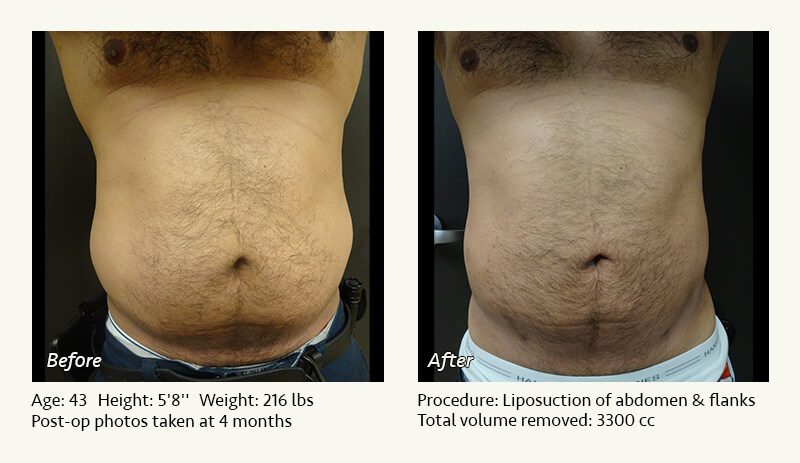
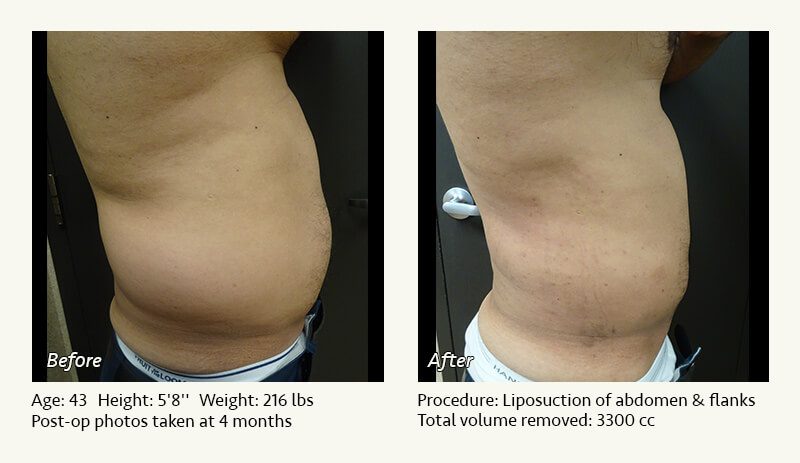
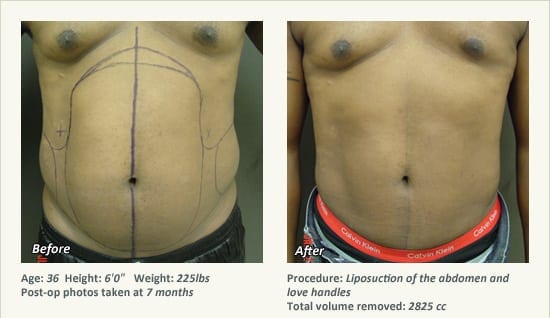
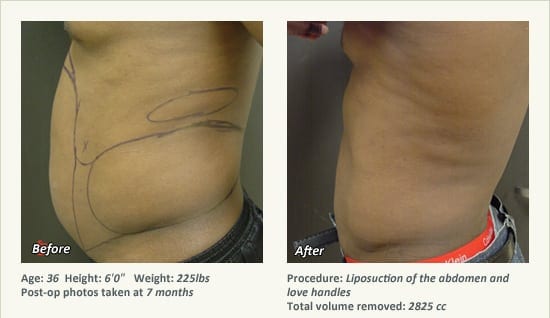
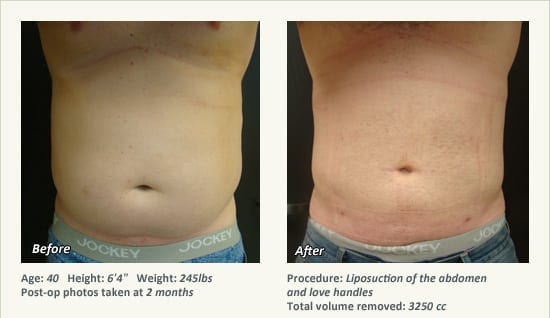
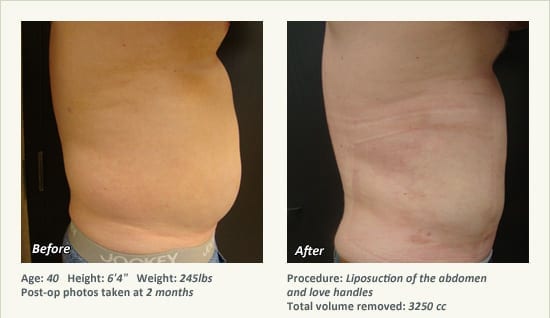
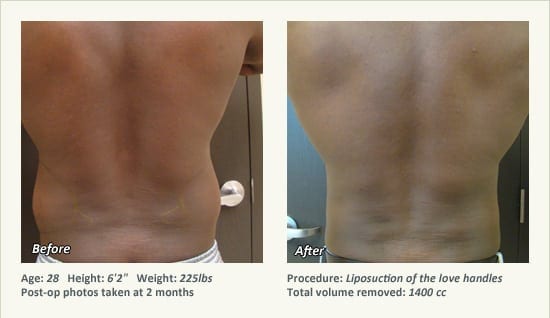
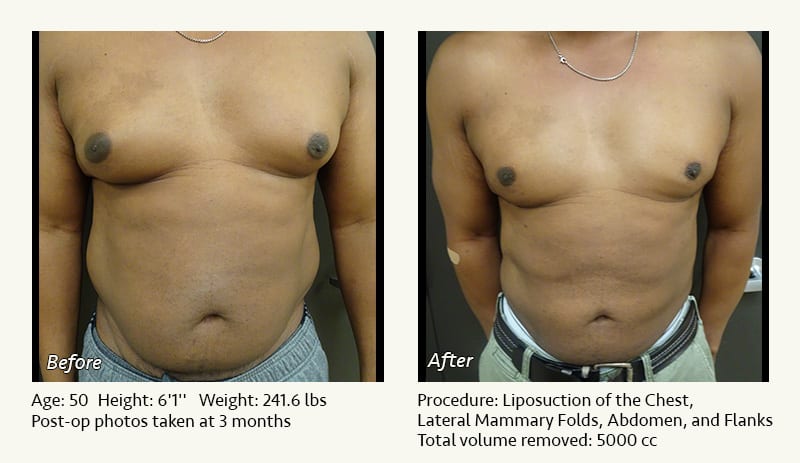
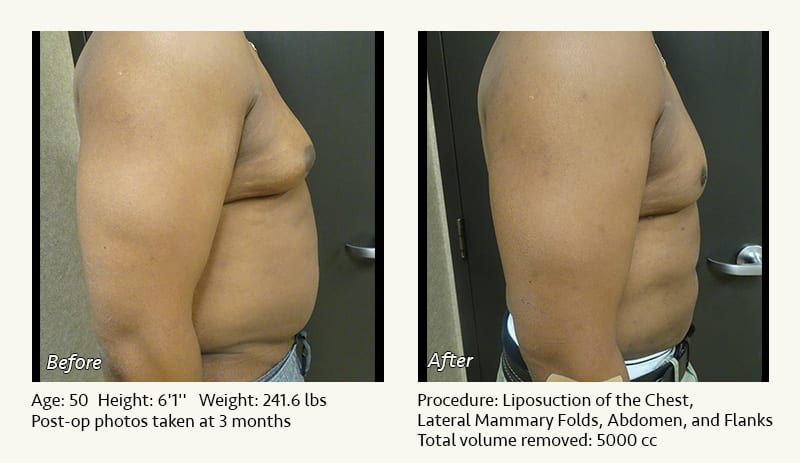
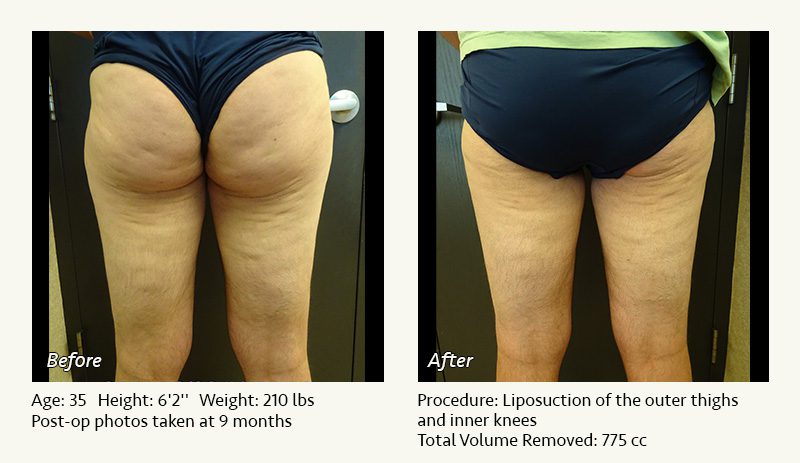
How is Liposuction Surgery Performed?
Dr. Friedman in Plano, Texas generally performs superwet liposuction to minimize bleeding and bruising after surgery. This involves the infiltration of a dilute fluid containing lidocaine (a local anesthetic) and epinephrine (adrenaline) into areas of excess fat. A hollow metal tube (cannula) is then inserted through quarter-inch skin incisions and passed back and forth through the fatty deposits. The cannula is attached to a vacuum source to remove the fat. Depending on the areas treated, fat removal may vary from several ounces to several pounds.
Dr. Friedman performs most liposuction under general anesthesia on an outpatient basis. The procedure is performed in his AAAASF-accredited surgical facility, the West Plano Plastic Surgery Center, which is located on the campus of Texas Health Presbyterian Hospital of Plano. He strictly uses physicians—not nurses or technicians—to administer your anesthesia.
Pain medication is necessary for about a week following surgery. Most patients return to light activities within 3 to 5 days, depending on the areas treated. A compression garment must be worn over the surgical sites continuously for one month and intermittently for a second month to maximize the surgical result.
When you visit our office in Plano, Texas, Dr. Friedman will discuss your specific concerns. He will give you a realistic idea of what you can expect from surgery. We will also show you a variety of “before and after” photos of liposuction procedures performed by Dr. Friedman. If you wish to speak to other men who have undergone these procedures, we will be happy to provide phone numbers.
Q & A: Liposuction
-
How does liposuction differ for men vs women?
Men generally concentrate excessive fat along the abdomen, love handles, and chest, rather than the hips or thighs. On average, men have thicker, more elastic skin than women, reducing the likelihood of significant skin laxity following liposuction.
-
Will the fat come back?
The fat cells that are removed by liposuction cannot regenerate. They are gone forever. However, if you gain 20 or 30 pounds, all bets are off. The remaining fat cells will become larger, and you will regain fat. The areas that were previously suctioned will be more resistant to weight gain than areas that were never treated. But all areas will enlarge to some degree if you gain weight after surgery.
If you maintain a stable weight after surgery, your results should last for many years.
-
Which liposuction technique is best?
Superwet, tumescent, ultrasonic, LASER, VASER…it gets pretty confusing.
Bottom line: any liposuction technique can yield good or bad results. The training and experience of the surgeon performing your procedure is probably far more important than the technique he or she uses. Evaluate surgeons based on their experience and surgical results.
-
What is mesotherapy?
Mesotherapy involves injection of various substances into the fat in an attempt to “melt” it. Mesotherapy is usually performed by non-plastic surgeons (most often nurses, family doctors, and gynecologists). Unfortunately, there is currently no “hard data” to support the use of mesotherapy. It is Dr. Friedman’s impression that mesotherapy does dissolve fat to some degree but does not do so uniformly. Frequently there are depressions at the injection sites without significant fat reduction in the adjacent tissues. This may give tissues an irregular, quilted appearance.
-
How much fat can you remove?
Dr. Friedman routinely removes 2 to 4 liters of fat on an outpatient basis. Although there is no fixed limit to fat removal, the American Society of Plastic Surgeons considers anything over 5 liters of fat removal to be “high volume liposuction.” High-volume liposuction must be approached with caution due to increased risk of fluid shifts, blood loss, and blood clots.
Bottom line: if you need more than 5 liters of fat removed, you should consider losing weight before surgery.
-
What about the fat under my chin?
Dr. Friedman usually performs submental (under the chin) liposuction under local anesthesia with nitrous oxide (laughing gas), rather than general anesthesia. Only one quarter-inch incision is required, and this is well-concealed. The procedure usually takes about 45 minutes. If desired, you can drive yourself home afterwards.
Liposuction: Recovery Instructions
One week before surgery
- Do not take aspirin-containing products, as these may increase your risk of bleeding. Use extra-strength Tylenol for any headaches or other minor pains.
- Please notify Dr. Friedman’s staff if you become sick with a fever, significant cough, etc. If necessary, your surgery can be rescheduled to a time when you are feeling better.
- Do not smoke at all or use a nicotine patch for at least two weeks (and preferably 4 weeks) prior to surgery and 4 weeks after surgery. Smoking interferes with wound healing and increases your risk for anesthetic and surgical complications.
- Arrange to have a relative or friend drive you home after surgery and stay with you for the evening. You cannot drive yourself home.
The evening before surgery
- Do not eat or drink anything for at least 8 hours prior to your scheduled surgery time.
- Make some jello and/or soup for after surgery. Have some juice in your refrigerator.
- The anesthesiologist will contact you by phone to discuss your medical history and to answer any questions.
Day of surgery: before you leave home
- Remember not to eat, drink, or smoke. This includes no chewing gum, mints, etc.
- Make sure someone is available to drive you home. Put a pillow and blanket in the car.
- Wear loose, comfortable clothing. Avoid heavy make-up, jewelry, or contact lenses. Please do not use any lotion, baby oil, perfume or powder. LEAVE ALL VALUABLES AT HOME!
Day of surgery: at the facility before surgery
- Dr. Friedman will talk to you before surgery to answer any last-minute questions. He will mark your areas of undesirable fat to help him accurately plan your surgery.
- You will meet the anesthesiologist and surgical nurses.
Day of surgery: at the facility after surgery
- You will be taken to the recovery area to wake up after surgery. Dr. Friedman will go to the waiting room to speak to your family/friends.
- Approximately 1 hour later, your family can visit you. Once you are feeling well enough, you may go home.
At home after surgery
- Have someone stay with you for the first night. You may be weak and drowsy.
- Take the antibiotics, pain medication (as needed), and anti-nausea medicine (if needed) that Dr. Friedman has prescribed for you.
- Sleep with your head elevated. Sleep on your back (not your stomach or side).
- Leave the compression garment on for 3 days. On the third day after surgery, you may temporarily remove the garment and the underlying foam padding and begin showering. Wash your garment and then put the foam and the garment back on. You may shower daily.
- It is common to experience temporary drainage from the incision sites, which may be blood-stained. If the drainage is bloody and persistent, contact Dr. Friedman.
- Take at least 10 deep breaths every hour. This will help keep your lungs expanded.
- Do not be a couch potato. To reduce the risk of blood clots in the legs, get up and walk any time you need to eat or use the bathroom. While you are in bed, repeatedly flex your ankles (moving your toes up and then down) and/or have your family massage your calves.
- If you experience a prolonged fever (oral temperature greater than 101), contact Dr. Friedman. Feel free to call our office or to page Dr. Friedman for any other problems or concerns.
Instructions for your first postoperative visit (about one week after surgery)
- Activity level 1 week after surgery: you may resume casual walking but must not engage in vigorous exercise that increases your blood pressure or heart rate. You may resume driving once you are off of your pain medication. Avoid freeways until you are comfortable with city driving. 4 weeks after surgery: you may gradually resume exercise activity. You should wear your compression garment while you are exercising.
- Sleeping position Please sleep on your back (flat or elevated) or part way over (pillow under your shoulder and hip). Do not sleep on your side until about 3 weeks after surgery. Unless otherwise instructed by Dr. Friedman, do not sleep on your stomach until about 8 weeks after surgery.
- Incision care You have Steristrips (butterfly tapes) over your incision. After these peel off (about 2 weeks after surgery), begin scar massage with Mederma twice daily. Mederma is available at our front desk or over-the-counter at your pharmacy. If you prefer, you may use Vitamin E or Aloe Vera. Continue scar massage for about 3 months.
- Massage You should begin massage to the suctioned areas one week after surgery. This will help smooth any irregularities and areas of firmness. A vibrating massager is generally effective. If you would like, we will provide you the phone number of a licensed massage therapist.
- Water exposure You may begin light showers 3 days after surgery. You should avoid scrubbing your incisions. Avoid the pool, lake, and ocean for 4 weeks.
- Medications One week after surgery, you may resume use of any medications or supplements that you discontinued prior to surgery. However, for at least 3 weeks, you should avoid Motrin, aspirin, and any other product that may thin your blood.
- Smoking Do not smoke for at least one month (and preferably much longer) after surgery. Smoking may increase your risk of infection, lung problems following anesthesia, and wound healing problems.
- Tanning You may tan whenever you like. However, you should use a high-SPF sunscreen (30 or greater) over your incisions for at least 6 months. Premature tanning of the incisions may cause them to darken permanently.
- Compression garment Wear the compression garment all day and all night (except for showers and massage) during the first month. You may gradually taper your use of the compression garment over the second month. If you have had liposuction of the thighs or knees, you may wish to wear elastic support hose for a few weeks to prevent ankle and foot swelling.
- Sex You may resume intercourse with the compression garment in place 2 weeks after surgery. You may resume intercourse without the compression garment 4 weeks after surgery.
Please feel free to ask Dr. Friedman or his staff about any additional questions or concerns.